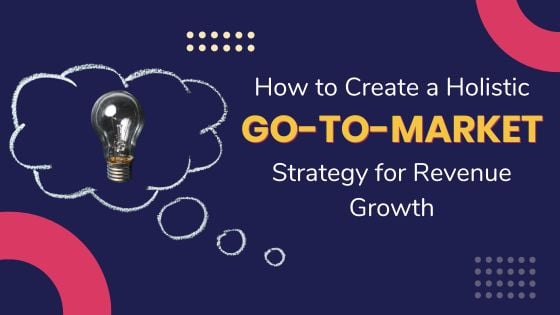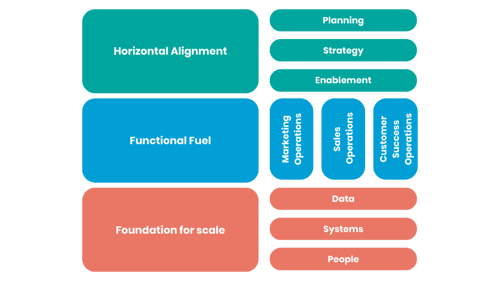


How to Create a Holistic Go-To-Market Strategy for Revenue Growth




A well-constructed go-to-market strategy can help you attract high-quality leads and drive revenue growth within the business.
But it isn’t as simple as it seems.
Your product, service, or offering may be exceptional and strategically positioned and there's no denying the talent and expertise of your sales and marketing team.
But despite all that is your GTM strategy not working as well as you hoped it would?
In this blog we’ll get down to the nitty-gritty of how to look at your go-to-market strategy from a holistic perspective, and how to build a go-to-market strategy that drives revenue growth.
For those starting from scratch or trying to understand what is a go-to-market strategy and what a go-to-market strategy framework looks like, hop right in.
But those of you who already have a GTM plan in place and are here to look for data-driven insights to optimise your current GTM plan, feel free to skip to the part where we discuss tips to ensure revenue growth within your GTM plan.
What is a Go-To-Market Strategy?
Before we lay down the process of creating a holistic go-to-market strategy for revenue growth let’s first understand what is a go-to-market strategy. In simple words, a go-to-market strategy is when every team in the company - sales, marketing, customer service, operations, etc. unite to contribute to delivering an exceptional customer journey through their product or service.
Your go-to-market strategy plays a pivotal role as a key mechanism that enables companies to effectively structure their approach to engage with customers and drive revenue growth.
At its core, a GTM plan is more than just a marketing strategy; it is a comprehensive blueprint that encompasses every aspect of bringing a product to market. This includes understanding the target customer, defining the value proposition, selecting sales and distribution channels, and crafting a message that will be communicated across all mediums.
Effective GTM strategies are inherently customer-centric, relentlessly focusing on the customer experience and how the product or service fulfils a need or solves a problem for the target market. This approach requires an in-depth understanding of customer behaviour, preferences, and pain points, as well as broader market trends and competitive dynamics.
By adopting this insights-driven approach, businesses can avoid the common pitfall of developing products in isolation from market needs, ensuring that their offerings are well-aligned with customer demands and thereby facilitating revenue growth.
Here’s a go-to-market strategy framework to help you understand better what is a go-to-market strategy.

Horizontal Alignment:
This involves aligning different aspects of the business horizontally to ensure coherence and synergy. This includes planning, where all teams collaborate to set objectives and strategies. Strategy involves developing a cohesive approach to achieving these objectives. Enablement focuses on empowering teams with the necessary resources and tools to execute the strategy effectively.
Functional Fuel:
This component focuses on the functional areas that drive the GTM strategy forward. Marketing operations ensure that marketing efforts are well-coordinated and optimised for success. Sales operations streamline the sales process and enhance efficiency. Customer success aims to ensure that customers are satisfied and supported throughout their journey with the company.
Foundations for Scale:
These are the foundational elements that support the scalability and sustainability of the GTM strategy. Data is crucial for making informed decisions and understanding customer behaviour. Systems refer to the technology infrastructure that enables seamless operations and data management. People are the talented individuals within the organisation who execute the strategy and drive results.
This go-to-market strategy framework helps you align teams, fuel your functional areas effectively, and establish strong foundations for scale, allowing businesses to create a robust GTM plan that drives revenue growth.
How to Build a Go-to-Market Strategy?
1. Identify Your Target Customer
Begin by conducting thorough market research to gain a deep understanding of your ideal customer profile and buyer persona. This involves analysing demographics, behaviour patterns, motivations, and pain points to ensure your product or service addresses a genuine need.
2. Define Your Value Proposition
Clearly articulate how your offering solves a problem or fulfils a need better than any other solution on the market. Your value proposition should be compelling, differentiating your product or service in a crowded marketplace.
3. Align Sales and Marketing
Break down the silos between your sales and marketing teams to ensure they are working towards the same goals. Use the insights gathered from market research to create unified messaging and content strategies that speak directly to your target audience's needs and preferences.
4. Leverage Customer Feedback
Incorporate feedback mechanisms across all customer touchpoints to continuously gather insights. This feedback should inform product development, marketing strategies, and sales tactics, ensuring your offerings remain relevant and desirable.
5. Optimise for the Customer Journey
Map out the customer's journey from awareness to purchase and beyond, optimising each stage for a seamless experience. This involves creating targeted content, employing effective sales techniques, and offering exceptional customer service to nurture leads towards conversion and foster loyalty.
6. Analyse and Adapt
Utilise data analytics to monitor the effectiveness of your GTM strategy, identifying areas for improvement and adjusting your approach in real-time. This data-driven approach ensures your strategy evolves in response to changes in customer behaviour, market trends, and competitive pressures.
Tips to Ensure Revenue Growth Within Your GTM Plan
You’re almost there!
To ensure your go-to-market strategy exceeds expectations and helps your teams meet their targets to drive revenue growth, it’s important to incorporate RevOps principles into your GTM plan.
![]()
Let’s see how you can do it:
1. Integrated Systems for Seamless Operations
Ensure that your systems are interconnected to facilitate a smooth go-to-market strategy execution. Integrated Customer Relationship Management (CRM), marketing automation, and sales tools play a crucial role in providing a unified view of customer interactions, thus streamlining processes and avoiding data silos.
2. Unified Data Platform for Informed Decision-Making
Establish a centralised data platform that aggregates information from various sources. This consolidated data hub serves as a single source of truth for revenue-related metrics, enabling accurate forecasting and supporting strategic marketing strategy decisions.
3. Data Quality Assurance for Reliable Insights
Maintain data accuracy and cleanliness through regular audits. Cleaning databases eliminates duplicates, outdated information, and inaccuracies, ensuring reliable data for making informed decisions critical for the success of your go-to-market strategy.
4. Cross-Functional Collaboration for Enhanced Customer Experience
Encourage collaboration among marketing, sales, and customer success teams to break down silos. This fosters communication and ensures everyone is working toward common goals, thereby enhancing the customer experience and accelerating revenue growth.
5. Customer Journey Mapping for Holistic View
Map out the entire customer journey, examining touchpoints from initial awareness to post-sale interactions. Understanding how different touchpoints impact revenue generation is crucial for optimising your go-to-market strategy.
6. Automated Task Handling for Efficiency
Leverage automation tools to handle repetitive and time-consuming tasks. Automation not only increases operational efficiency but also reduces errors, allowing teams to focus on high-value activities contributing directly to revenue growth.
7. Analytics and Reporting for Real-Time Insights
Implement robust analytics and reporting mechanisms to track key performance indicators (KPIs) related to revenue generation. Utilise dashboards providing real-time insights into revenue forecasts, go-to-market performance, account health, and pipeline performance.
8. Regular Performance Reviews for Continuous Improvement
Conduct regular reviews of your go-to-market strategy performance. Assess the effectiveness of each stage and make data-driven adjustments as needed. This iterative approach ensures continuous improvement and adaptation to market dynamics.
9. Training and Development for Skill Enhancement
Invest in training programs to enhance the skills of your teams in using consolidated systems and interpreting data. Well-trained teams are better equipped to leverage the full potential of integrated operations, leading to improved revenue outcomes.
By consolidating operations, systems, and data, and implementing these RevOps-inspired tips, businesses can establish a strong foundation for a streamlined and data-driven go-to-market strategy that maximises revenue growth and ensures sustained long-term growth.








